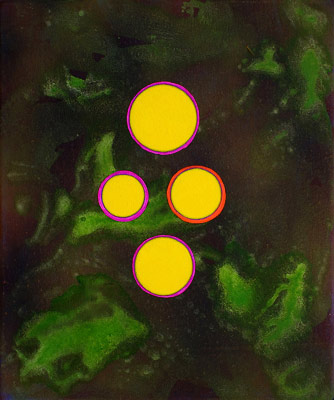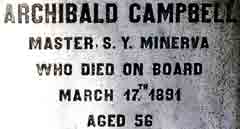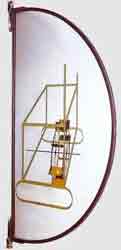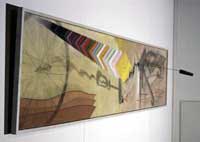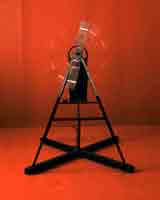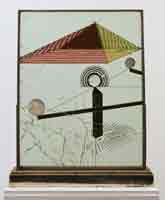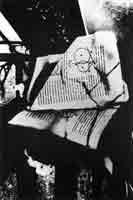Handler of Gravity
sitemap
drawings
paintings 1 2 3 4 4 5 a b c -
- A B . . . . . . . new
installations
projects
reviews
Archibald Campbell (1835-1891) |
Archibald Campbell (1835-1891) |
Handler of Gravity
Marcel Duchamp and the New Geometries (Part 1)
Marcel Duchamp and the New Geometries (Part 2)
Marcel Duchamp and the New Geometries (Part 3)
Marcel Duchamp and the New Geometries (Part 4)
Linda Dalrymple Henderson
Marcel Duchamp and the New Geometries (Part 5)*
The similarity that Duchamp believed he had discovered between the properties of a mirror and those of the four-dimensional continuum could only have added to his appreciation of mirrors. Another association of mirrors with the fourth dimension may also have been in the artist's mind. Mirror images are closely connected with the three-dimensional symmetry that had long been pointed to by popularizers of the fourth dimension as proof of its existence.
Often citing Kant's discussion of right and left hands, popularizers of the fourth dimension argued that a fourth dimension of space was necessary in order for one symmetrical three-dimensional object to be "turned" into the other. Such a "turning" would have to occur about a four-dimensional "hinge plane" and, as has been noted, Duchamp's interest in the notion of hinges is apparent in his notes for the Large Glass. "Perhaps make a hinge picture," he had suggested in a note in the Green Box, concluding, "Find an automatic description of the hinge. Perhaps introduce it in the Pendu femelle."[109] Although he does not seem to have introduced his hinge principle into the Bride herself, Duchamp did actually execute a "hinge picture," the Glider Containing a Water Mill in Neighboring Metals of 1913-1915. Just as this painting on glass can be rotated to allow viewing of its mirror, image verso, so too the Large Glass itself can be viewed from the back. Although the look of the applied materials is necessarily somewhat different from the back, there is at least a general indication of the sym, metrical counterpart of each image.
Marcel Duchamp; Glider Containing a Water Mill in Neighboring Metals, 1913-15, oil and semicircular glass, lead, lead wire. 147 x 79 cm. (The Philadelphia Museum of Art)
Popular literature connecting mirrors and the fourth dimension would have rein, forced Duchamp's interest in the mirror as well. Lewis Carroll's Through the Looking Glass dealt with the themes of chess and mirrors, with definite overtones of higher dimensions. Although less likely to have been known to Duchamp, George MacdonaId's 1895 fantasy Lilith made use of multiple mirrors in a way that parallels Duchamp's interest in A l'infinitif in a "3-sided mirror."[110] Having been led to a secret garret through which his mentor, Mr. Raven, regularly escaped to the fourth dimension, Macdonald's narrator recounts the way in which rays reflected from one mirror "seemed to go clean through" a second mirror.[111]
Once Duchamp arrived in the United States in 1915 and began the execution of the Large Glass, he would have been further supported in his thinking (or, at least, amused) by Hyland Clair Kirk's curious story entitled "The Fourth Dimension," published in Open Court magazine in December 1913. The hero of the tale Was a Professor Purcellini, a proponent of the fourth dimension, who wagered that he could "make clear and comprehensible to others, five degrees of ideal "representation" of a young man named Tommy Jones:
The first degree, as presented by Purcellini, was the thought of Tommy when absent; which would necessarily apply to the other stages. The second was a series of moving-photos representing Tommy walking about. The third consisted of the photos of the reflections in a mirror of Tommy in· action. The fourth was made Up of the moving-photos of a shadow of Tommy reflected in a mirror. As to the fifth, Purcellini said:
"Now, gentlemen, all you have to do to realize the fifth degree is, to dream about this moving shadow of Tommy and then recall your dream the next morning, and you have: first, your immediate photo reflected in the mirror; second, the dream-shadow of Tommy's photo reflected in the mirror; third, the photo of the shadow reflected in the mirror; fourth, the shadow reflected; and fifth, the shadow of Tommy."[112]
Kirk's is one of the few stories in the literature on the fourth dimension that combines this notion with shadows, mirrors, and photography, as Duchamp was in fact to do.
When it came to the actual fabrication of the Large Glass, the mirror as three-dimensional shadow or two-dimensional mold with three virtual dimensions proved more fruitful than Duchamp's association of mirror space with higher dimensions. "The 4-dim'l continuum" as "mirror of the 3-dim'l continuum" could only be appreciated after a detailed geometrical "proof' and thus could not be convincing on visual evidence alone. To add a fourth dimension to his two-dimensional mirror image with three virtual dimensions, Duchamp now returned to the shadow idea originally voiced in his note based on Jouffret, "The shadow cast by a 4-dim'l figure on our space is a 3-dim'l shadow." Put differently in another note,
Each ordinary 3-dim'l body, inkpot, house, captive balloon is the perspective projected by numerous 4-dim'l bodies upon the 3-dim'l medium.
There are 3-dim'l bodies which correspond to fewer perspective projections (in the 4 to 3-dim'l region) than others. One would have to construct/determine those which are the projection of a single 4-dim'l body (4-dim'l Perspective).[113]
This is now the Bride as Duchamp later described her to Cabanne and others. The term "4-dim'l Perspective" appears in this note, but the attempts at a tactile understanding of the fourth dimension have now been replaced by talk of projections aided by the illusion of a mirror. The final Bride is a projection of the fourth dimension in the form of a three-dimensional geometrical section, which in turn has been reduced to the two dimensions of the glass.
For one as fascinated with the passage from one dimension to another as Duchamp, the production of the Bride was a particularly interesting experiment. Duchamp had originally planned to transfer her image photographically onto the glass.[114] When this method proved impossible, however, he carefully painted her in tones of black and white, preserving her look of three-dimensionality just as the photographic negative would have done. While a mirror was not actually employed in the reduction of the Bride to two dimensions, she may nevertheless be thought of as a kind of mirror image of the three-dimensional Bride. As Duchamp stated in one of the notes on mirror space, "Analogy between: Reflection in a plane mirror and the 3-dim'l section of a 4-dim'l body by a 3-dim'l space--."[115]
Duchamp's comments on molds, mirror images, and photographic negatives in his notes under "Appearance and Apparition" were equally concerned with the lower section of the Large Glass: the Bachelors are likewise the apparition of an appearance. However, the elements of the Bachelor Apparatus are set in a strict perspective system, which establishes them unmistakably as three, dimensional forms. While the glass panels allow the Bride to hang free of any indication of the space she inhabits, the forms of the Bachelor Apparatus appear to be actual three-dimensional objects spread out on the floor behind the Large Glass. Thus, the glass itself adds to the distinction between the Bride as a two- and three-dimensional reflection or projection of the fourth dimension and the very earthbound Bachelors.
In the execution of the Large Glass Duchamp made good use of the knowledge gained during his study of n-dimensional geometry during late 1912, 1913, and 1914. Admittedly, Duchamp's geometry as revealed in A l'infinitif is not flawless. In the early stages of his research into n-dimensional geometry, when he was staying close to texts like Jouffret or Poincare, Duchamp's notes are accurate reflections of the laws of four, dimensional geometry. But later, when he began simply to jot down his thoughts on the way four, dimensional vision and the geometry of the continuum would operate, inaccuracies do appear.
These shortcomings, however, should not obscure the fact that Duchamp's under, standing of the new geometries was far greater than that of any of the Cubist painters. While he began as they did, with Poincare's discussion of tactile and motor sensations, his study of three, dimensional perspective and four-dimensional geometry soon led him beyond a tactile "four-dimensional perspective." If certain aspects of his final understanding of the four-dimensional continuum in terms of virtual images and Dedekind cuts were too complex to be employed visually, they reminded Duchamp again of the role that could be played by a mirror. From a visual illusion of the fourth dimension created by a mirror as four, dimensional reflection of the three, dimensional world, Duchamp finally settled on his alternative view of the mirror as two-dimensional mold with three virtual dimensions.
Four-dimensional geometry, as he had first discovered it in Jouffret, provided the theoretical support for his Bride to be the section or shadow of a four-dimensional Bride. Painted on glass with the three virtual dimensions of a mirror image or a photograph, the Bride was a testament to Duchamp's scholarly effort. He had indeed succeeded in moving beyond the tactile and motor orientation of Cubism and had created a unique projection of the fourth dimension.
Later Works
Duchamp's concern with the interplay of dimensions reached new heights in Tu m’, his last oil painting on canvas, painted in New York in 1918. Tu m’ no longer relies on glass and mirrors, but is rather a two-dimensional canvas augmented by the presence of actual three-dimensional objects. In this work dedicated to blurring the line between illusion and reality, shadows are responsible for the passage from one dimension to another. Duchamp's three-dimensional Readymades were the sources of several of the shadows, and the three-dimensional objects incorporated in the canvas themselves become a type of Readymade.
Marcel Duchamp; Tu m’, 1918, oil on canvas, with bottle brush, three safety pins, and one bolt, 69.8 x 303 cm. (Yale University Art Gallery)
Two of Duchamp's notes made at the time of his conception of the Large Glass look forward to the method of Tu m’. The first note, published separately as "Cast Shadows," begins,
probably to relate to the notes on 4-dim'l perspective.
after the bride ....
make a picture. of shadows cast
by objects 1st on a plane.
2nd on a surface of
such (or such) curvature
3rd on several transparent surfaces
thus one can obtain a hypophysical
analysis of the successive transformations
of objects. (in their form, outline-) ...[116]
In Tu m’ Duchamp concentrated on shadows cast on a plane, as he had worked with shadows on glass in the Large Glass. Nevertheless, the non-Euclidean Three Standard Stoppages are present in Tu m’, and their appearance beneath the shadows of the Bicycle Wheel and Hat Rack at least suggests the projection on a curved surface mentioned in Duchamp's note. In fact, the lines receding from the curved lines of the Stoppages on the right, hand side of the canvas create an illusion of three-dimensional non-Euclidean space.
A note in the Green Box raises the possibility of the direct involvement of the fourth dimension in Tu m’ as well. While the first line of this note, "shadow cast by 2, 3, 4, Readymades. 'brought together,"[117] leads into a discussion of a kind of composite shadow to be produced, in Tu m’ Duchamp's "2, 3, 4, Readymades" have become 2-dim'l, 3- dim'l, 4-dim'l Readymades. Most obvious in Tu m’ are the two-dimensional shadows of Duchamp's three-dimensional Readymades, the Bicycle Wheel and the Hat Rack. While the trompe-l'oeil hand, painted by the sign painter A. Klang, is actually two, dimensional, its look of three-dimensionality suggests that it, like the Bride, may be a three, dimensional shadow or "mirror image." Shadows cast by two-dimensional Readymades are more difficult to discover in Tu m’. However, departing from the strict definition of Readymade, the lines produced by the Three Standard Stoppages might be understood as one-dimensional "shadows" of the meter sticks of the new measure that Duchamp had created in 1913, 1914.
In view of Duchamp's belief that three-dimensional objects are shadows of four, dimensional forms, the bottle brush, the three safety pins mending the illusionistic tears in the canvas, and the bolt in the first paint sample may logically be interpreted as shadows from the fourth dimension. The idea of a four-dimensional "Readymade" producing a shadow like the bottle brush would surely have pleased Duchamp, and one other shadow in Tu m’, that of a corkscrew, is known to have resulted from a nonexistent Readymade.[118]
John Dee has compared Duchamp's interest in the spiral, as manifested in the corkscrew in Tu m’, to Hinton's use of a spiral in his model of higher dimensional consciousness.[119] Noting also the spiral form in Duchamp's sketches for the "Handler of Gravity", who was to have transcended the division between Bride and Bachelors in the Large Glass, and the spiraling optical effects of the 1920 Rotary Glass Plates and the 1925 Rotary Demisphere,[120] Dee suggests a possible association with Hinton in all of these works. In fact, it is quite likely that that spiral did have associations with the fourth dimension for Duchamp. In addition to Hinton, Jarry had used a spiral to describe the manner in which the deceased Faustroll's body was entwined by the "progress of the solid future," as the pataphysician himself "assumed the realm of the unknown dimension."[121]
Marcel Duhamp; Rotary Glass Plates (Precision Optics), 1920.
The gravity component of Duchamp's "Handler of Gravity" itself may also have had a four-dimensional association for Duchamp. Gravity had played a central role in Hinton's discussion of the process of educating the "space sense" in his 1888 A New Era of Thought.[122] The first of the "self elements" in perception that was to be "cast out" was the sense of gravity, which would cause any observer of Hinton's block of twenty-seven cubes to order the set in a predictable way. Since Hinton's goal was a totally free and reversible perception, the sense of left and right also had to be overcome. It was with the question of left and right hands that Hinton then introduced the need for a higher dimension of space, through which one hand could be turned into the other. Duchamp refers to gravity and to the need to escape up/down or left/right orientation in a number of the notes in A l'infinitif, as well as in the 1980 publication of his Notes.[123] This theme drawn from Hinton was also to be a major preoccupation of several members of the Russian avant-garde in their pursuit of the fourth dimension.
In Tu m’ Duchamp produced a world of shifting dimensions and non-Euclidean space.[124] His concern with a "gliding system of dimensions and realities"[125] was to continue in his work with the rotary plates of his "precision optics," as well as in his experiments in making stereopticon slides. Duchamp painted his stereopticon slides (The Museum of Modem Art, New York) in Buenos Aires during a nine-month stay in 1918-1919. At the same time Duchamp was creating a small work on glass entitled To Be Looked at (from the Other Side of the Glass) with One Eye, Close to, for Almost an Hour. To Be Looked at is a study for the lower right-hand section of the Large Glass and comments playfully in its title on the requirements of one-point perspective. While the lower portion of the glass panel, with its trace of an "Oculist Witness" and the tip of the "Scissors" of the Bachelor Apparatus, relates directly to the Large Glass, the strange pyramidal form suspended above the central lens is more mysterious. With Duchamp's interest in visual effects and optics growing, it may possibly be explained as an experiment involving the interplay of the red, green, and yellow stripes of the various sides of the form.
Marcel Duchamp; To Be Looked at (from the Other Side of the Glass) with One Eye, Close to, for Almost an Hour, Buenos Aires, 1918. Oil, silver leaf, lead wire, and magnifying lens on glass (cracked), mounted between panes of glass in a standing metal frame, 51 x 41.2 x 3.7 cm.
This irregular "pyramid" might thus have been Duchamp's own invention for this purpose. At the same time, it does suggest comparison with certain drawings from Jouffret's Melanges de geometrie d quatre dimensions. In this particular illustration Jouffret was developing the four-dimensional hexadekahedroid, having shaded one of its component tetrahedrons shown in several different views. The result of this technique is quite different from Jouffret's perspectives cavalieres and other diagrams of the Traite elementaire. It seems possible that the interesting visual properties of such diagrams, along with their association with the fourth dimension, stayed in Duchamp's mind and resurfaced with his new interest in optical effects.
One of Duchamp's last specific comments on geometry was his Unhappy Readymade of 1919. At the time of the marriage of his sister, Suzanne, to Jean Crotti, the artist sent instructions to the couple in Paris to suspend a geometry book by strings on their balcony. Duchamp later described the intended results: "The wind had to go through the book, choose its own problems, turn and tear out the pages .... It amused me to bring the idea of happy and unhappy into readymades, and then the rain, the wind, the pages flying, it was an amusing idea."[126]
Marcel Duchamp; Unhappy Readymade, 1919.
In the Unhappy Readymade the more familiar irreverent Duchamp appears to have replaced once again the scholar revealed in the A l'infinitif notes. Duchamp's days of concentrated geometric scholarship were largely over by the time he left France in 1915 and were certainly so by 1919. Still, it is not the new geometries that the Unhappy Readymade subverts, for the geometry text hung on the balcony deals with Euclidean plane geometry.[127] In fact, the result of action by the wind and rain would be non- Euclidean: the inevitable buckling and tearing of the pages would produce non-Euclidean deformations of the Euclidean diagrams in the text.
With the recognition that the theoretical four-dimensional effects he had planned in his notes for the Large Glass could not be realized physically on his glass panels, Duchamp turned in 1920 to experiments in optics as the means by which he might actually perceive higher dimensional space. His Rotary Glass Plates of 1920, Rotary Demisphere of 1925, and other experiments with spiraling disks document Duchamp's interest in moving from one dimension to another by means of a spiral in motion. Once again, as at the beginning of his career, Duchamp turned to the generation of virtual volumes in motion, in the tradition of Marey. The Rotary Glass Plates, when activated, create a spiraling effect of motion in and out of depth, as do the seven spiral disks Duchamp designed in 1923 (Seattle Museum of Art, Eugene Fuller Memorial Collection).[128] Utilized in his 1926 film Anemic Cinema, Duchamp's experiments with two-dimensional disks culminated in the mass-produced Rotoreliefs of 1935. A more complex device, the Rotary Demisphere, adds a physical third dimension as the starting point for dimension-raising spirals.
To assure the desired spatial effect, Duchamp, with the help of his photographer friend Man Ray, added the concept of stereoscopy to these experiments. Man Ray took at least one stereoscopic photograph of the Rotary Glass Plates at rest, and the two men made a stereoscopic film (in red and green) of the Rotary Demisphere in motion in 1925 (Collection of Man Ray, Paris).[129] Apparently, Duchamp reasoned that if a two-dimensional pattern rotating could generate a three-dimensional virtual image for one eye, stereoscopy’s orientation to two eyes should allow a three-dimensional pattern to generate a virtual image of four dimensions.
Stereoscopy and the related idea of the anaglyph (two superimposed stereoscopic images) continued to intrigue Duchamp to the end of his life.[130] However, with the eclipse of interest in "the fourth dimension," following the popularization of Relativity Theory during the 1920s, Duchamp's commitment to the new geometries was never again as intense. If, as François Le Lionnais recalls,[131] Duchamp remained an advocate of Poincare throughout his life, the early twentieth-century interpretations of the fourth dimension that had been so central to his own development had lost their cogency.
Duchamp's comments on the fourth dimension in interviews of the 1960s suggest this sense of distance from the 1910s. In an interview with Dore Ashton, published in 1966, Duchamp concluded his discussion of the Cubist era's concern with the new geometries by stating, "I'd say I liked the fourth dimension as one more dimension in our lives .... Now, you know, I live in three dimensions. It was mostly talk with us, but it did add an extra-pictorial attraction."[132] And, in a 1967 interview in answer to Jeanne Siegel's query whether his interest in the fourth dimension had continued, Duchamp explained, "Yes, this is also a little sin of mine, because I'm not a mathematician and I'm now reading a book on the fourth dimension and notice how childish and naive I am about that fourth dimension so that I just jotted down these notes thinking I could add something to it but I can see that I'm really a little too naive for this kind of work."[133]
In New York in the 1940s Duchamp had been in close contact with the Surrealists Andre Breton and Matta Echaurren, who were fascinated by a fourth dimension reinterpreted in the light of Relativity Theory. Since the 1920s, time had become a regular component of discussions of the fourth dimension, including J. W. Dunne's An Experiment with Time, which Duchamp was to cite in a footnote included in the printed text of A l'infinitif in 1966.[134] Although Dunne's book would hardly have overwhelmed Duchamp in the manner he described to Siegel, an exposition of the four-dimensional space-time continuum of Relativity Theory could certainly have made his own earlier ideas seem "naive." Whatever the case, overt references to the new geometries, which by the 1940s were over a century old, are rare in Duchamp's later works. The two primary exceptions to this statement, the cubic image used in Duchamp's 1925 poster for the French Chess Championship and repeated in his 1968 etching King and Queen, and his "mile of string" installation for the 1942 First Papers of Surrealism exhibition, are discussed below in Chapter 4 and the Conclusion, respectively.
Perhaps the major thread of continuity with his earlier preoccupation with dimensionality was Duchamp's later speculation on "inframince" or "infrathin."[135] For Duchamp, "inframince" represented the qualitative degree or step by which one form turns into another, a quality he found at the critical point of transition from line to plane to solid and beyond. In Duchamp's view, if a geometric plane (or a sheet of paper) is considered a two-dimensional concept with an "infinitely thin" extension in the third dimension to give it physical presence, "infr8mince" intervenes at the point the extension enlarges to transform the plane into a three-dimensional solid. It has been suggested that Duchamp's term "inframince" relates to Jouffret's discussion of a tranche infiniment mince or "infinitely thin slice" or plane.[136] Moreover, Hinton had argued that the fourth dimension might be embodied in a minute extension in a fourth direction comparable to the "thickness" of a plane.
Yet, "inframince" had a significance for Duchamp that went far beyond its geometric origins. In a note published in View in March 1945, Duchamp presented one of the many nongeometric interpretations of "inframince": "When / the tobacco smoke / also smells / of the mouth / which exhales it / the two odors / are married / by infra-thin."[137] As he explained to Denis de Rougement later that year, he "chose on purpose the word thin which is a word with human, affective connotations, and it is not an exact laboratory measure. The sound or music which corduroy trousers, like these, make when one moves, is pertinent to infra-thin."[138]
A similar generalizing on the subject of dimensions, most noticeably in the direction of eroticism, can be seen in Duchamp's works of the post-World War II period. If, as Jean Clair has suggested, Duchamp's interest in molds and topology underlies his Female Fig Leaf of 1950 (Collection D.R.A. Wierdsma, New York) and Objet-Dard of 1951 (Collection Mme. Marcel Duchamp, Villiers-sous-Grez),[139] the connection with higher dimensions is much less specific. Likewise, an erotic, less geometric "fourth dimension" must be posited in order to interpret the nude in Duchamp's Etant donnes: 1 la chute d'eau, 2 le gaz d'eclairage (1946-1966) (Philadelphia Museum of Art) as the three-dimensional projection of the four-dimensional Bride beyond the Large Glass.[140]
With "inframince" and his later works Duchamp's earlier pursuit of higher spatial dimensions and non-Euclidean curvature was extended from "playful physics" to a "playful" philosophy for living. No longer did Duchamp need a scholarly knowledge of the "new" geometries to support his iconoclasm. It had become a way of life.
* Linda Dalrymple Henderson, The Fourth Dimension and Non-Euclidean Geometry in Modern Art (Princeton: Princeton University Press, 1983), Chapter 3, "Marcel Duchamp and the New Geometries," pp. 153-163.
Notes:
[109] Duchamp, Green Box, in Salt Seller, p. 27. Jean François Lyotard, in various texts now collected in us Transformateurs Duchamp (Paris: Editions Galilee, 1977) discusses the importance of both hinges and mirrors in Duchamp's thinking.
[110] Duchamp mentions such a mirror in two notes in A l'infinitif (Salt Seller, pp. 88, 94). Paul Carus had discussed the optical effects of three mirrors placed at right angles in his article, "Space of Four Dimensions," The Monist (Chicago), XVIII (July 1908), 473. However, Duchamp would not likely have encountered. this article before his first trip to the United States in 1915, even though The Monist was available at the library of the Universite de Paris.
[111] Macdonald, Lilith, p. 53. There is one other connection of mirrors with separate and very different worlds which may also have been known to Duchamp. In "On the Origin and Significance of Geometrical Axioms" (pp. 57-58) Helmholtz had suggested that the world seen within a convex mirror offers an image of non-Euclidean space. Poincare had elaborated upon Helmholtz's curved mirror model in Science et methode, pp. 101-102 (The Foundations of Science, pp. 416-17).
[112] Hyland Clair Kirk, "The Fourth Dimension," Open COUrt (Chicago), XXVII (Dec. 1913), 747.
[113] Duchamp, A l'infinitif, in Salt Seller, p. 96.
[114] d'Harnoncourt and McShine, eds., Marcel Duchamp, p. 263. In Duchamp et Ia photographie (pp. 46- 50) Clair discusses Duchamp's idea of the Large Glass as a "giant photographic plate."
[115] Duchamp, A l'infinitif, in Salt Seller, p. 91. Duchamp had combined the ideas of the mirror and photography in an earlier note in A l'infinitif: "Have a room entirely made of mirrors which one can move-and photograph mirror effects ..." (p. 76).
[116] Duchamp, "Cast Shadows," in Salt Seller, p. 72.
[117] Duchamp, Green Box, in Salt Seller, p. 33.
[118] Schwarz, Complete Works, p. 470.
[119] Dee, "Ce Façonnement symetrique," pp. 370- 71.
[120] Linde had already noted the theme of the spiral in Tu m', the "Handler of Gravity," and Duchamp's optical experiments in "La Roue de bicyclette," in L'Oeuvre de Marcel Duchamp, III, 40-41. Suquet's La Gueridon et Ia virgule provides the fullest analysis to date of the "Handler of Gravity."
[121] Jarry, Gestes et opinions, p. 105.
[122] Hinton had first outlined the process of "casting out the self' in an essay of this title in Scientific Romances, 1st ser. (London: Swan Sonnenschein, Lowrey & Co., 1886). See A New Era of Thought of 1888, pp. 21-46, where Hinton repeated his discussion. While Hinton had seen the sense of gravity as an obstacle to enlarging one's perceptions, gravity itself was at times connected to the fourth dimension in a positive sense. Boucher, for instance, in his 1903 Essai sur l'hyperespace (p. 122), had suggested that gravitational force was perhaps transmitted by means of a fourth direction in space. See again Chapter I, n. 100, for Boucher's source in the writings of W. W. Rouse Ball.
[123] See Salt Seller, pp. 33, 57, 65, 87, 90, 100. In the 1980 publication of Duchamp's Notes, see, e.g., the notes numbered 55, 66, 99, 104, 151, 180.
[124] Clair adds further insights into Tu m' by considering the anamorphic aspects of the work in "Marcel Duchamp 'et la tradition des perspecteurs," in L'Oeuvre de Marcel Duchamp, III, 150-53.'
[125] K. G. Pontus Hulten, The Machine as Seen at the End of the Mechanical Age, ex. cat. (The Museum of Modem Art, New York, 25 Nov. 1968-9 Feb. 1969), p. 103.
[126] Duchamp, as quoted in Cabanne, Dialogues, p. 61.
[127] The diagram visible in the photograph of the Unhappy Readymade illustrates the "radical axis of two circles," from which tangents drawn to the two circles will always be equal (Theorem 36 of Book 3 of Euclid's Elements).
[128] Clair discusses Duchamp's optical experiments in Duchamp et la photographie and notes an eyewitness account of the spiraling effect of the Rotary Glass Plates (p. 94).
[129] For this little-known photograph, see Clair, Duchamp et la photographie, p. 95. Duchamp discussed his interest in film as a means to "express [another] dimension" in a 1963 interview with Francis Roberts, "I Propose to Strain the Laws of Physics," Art News, LXVII (Dec. 1968), 46.
[130] On Duchamp's last work, Anaglyphic Chimney of Sept.-Oct. 1968, and the subject of anaglyphs in general, see Clair, Duchamp et la photographie, pp. 82-86.
[131] François Le Lionnais, in "Marcel Duchamp as a Chess Player and One or Two Related Matters" (interview by Ralph Rumney), Studio International, CLXXXIX (Jan.-Feb. 1975), 24.
[132] Duchamp, as quoted in Ashton, "An Interview," p. 245.
[133] Duchamp, as quoted in Siegel, "Some Late Thoughts," p. 21.
[134] Duchamp, A l'infinitif, in Salt Seller, p. 101. See J[ohn] W[illiam] Dunne, An Experiment with Time (London: A. & c. Black, 1927), and numerous subsequent editions.
[135] The extent of Duchamp's later theorizing on "inframince" only became known with .the recent publication of the final set of his Notes. On this concept, see Clair, Duchamp et la photographie, p. 98, as well as the extensive analysis of the idea in Adcock, "Marcel Duchamp's Notes."
[136] See Dee, "Ce Façonnement symetrique," p. 3, and Adcock, "Marcel Duchamp's Notes," pp. 98ff.
[137] Duchamp, untitled note, View, v (Mar. 1945), n. pag.; trans. in Salt Seller, p. 194.
[138] Duchamp, as quoted in Denis de Rougement, "Marcel Duchamp, mine de rien," Preuves, no. 204 (Feb. 1968), pp. 45-46.
[139] See Clair, "Sexe et topologie," in L'Oeuvre de Marcel Duchamp, pp. 52-59.
[140] For this view, see, for example, Anne d'Harnoncourt and Walter Hopps, "Etant Donnes: 10 la chute d'eau, 20 le gaz d'eclairage: Reflections on a New Work by Marcel Duchamp," Philadelphia Museum of Art Bulletin, LXIV (Apr.-Sept. 1969), 16-17.
